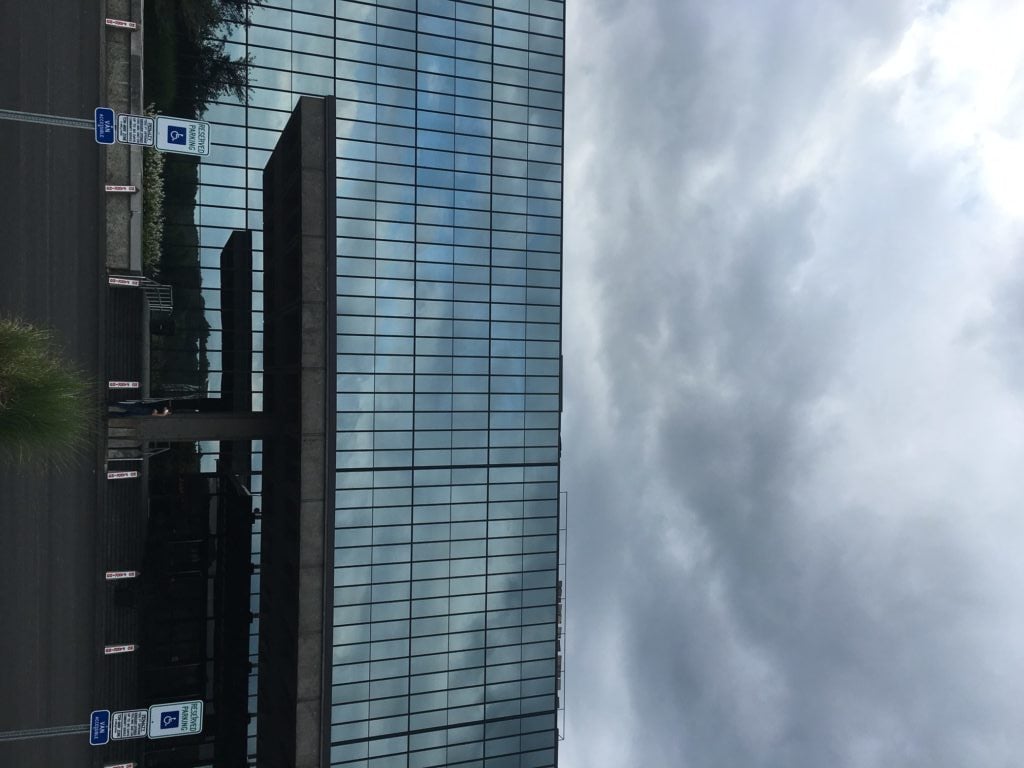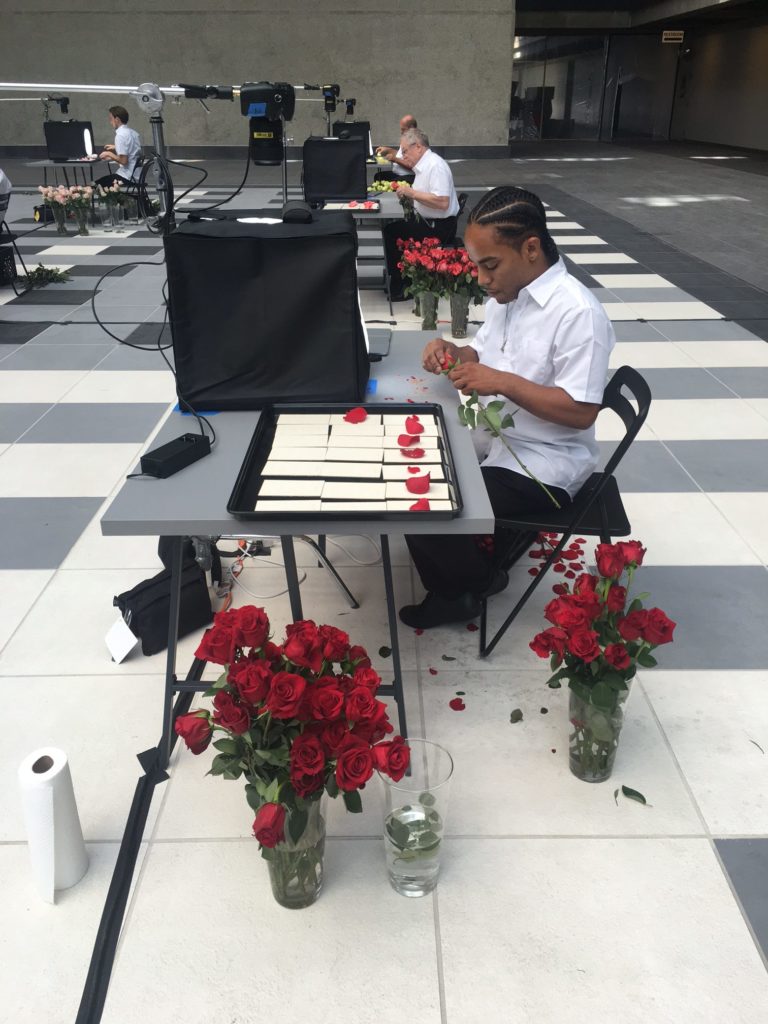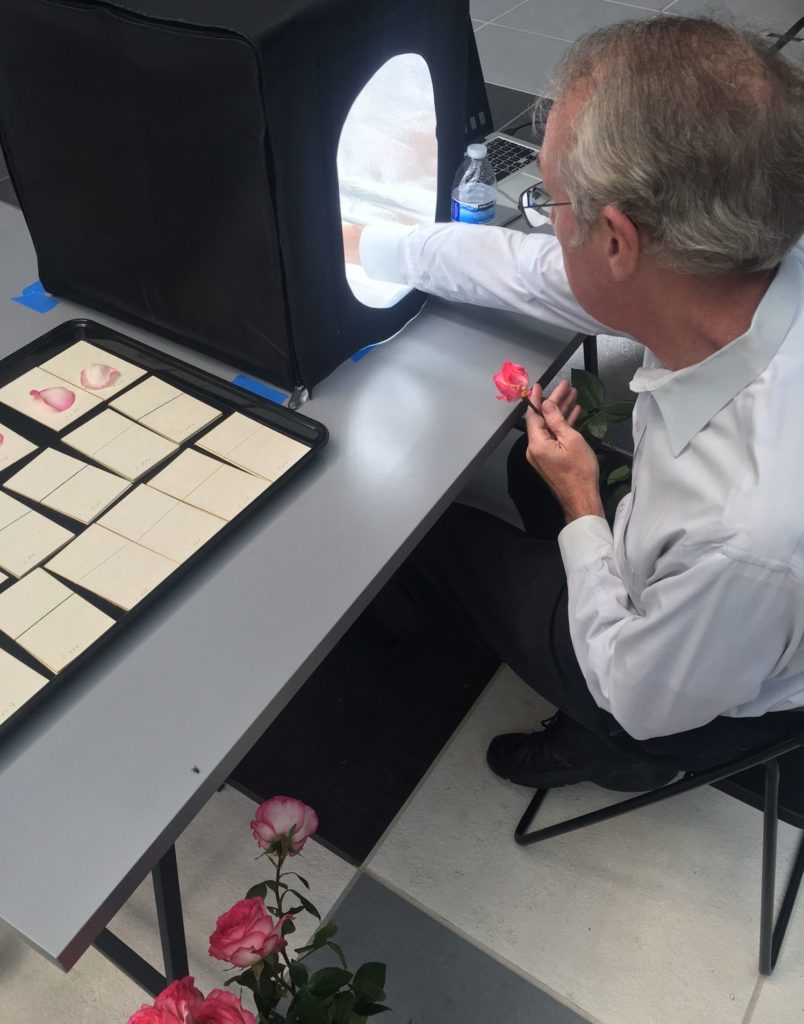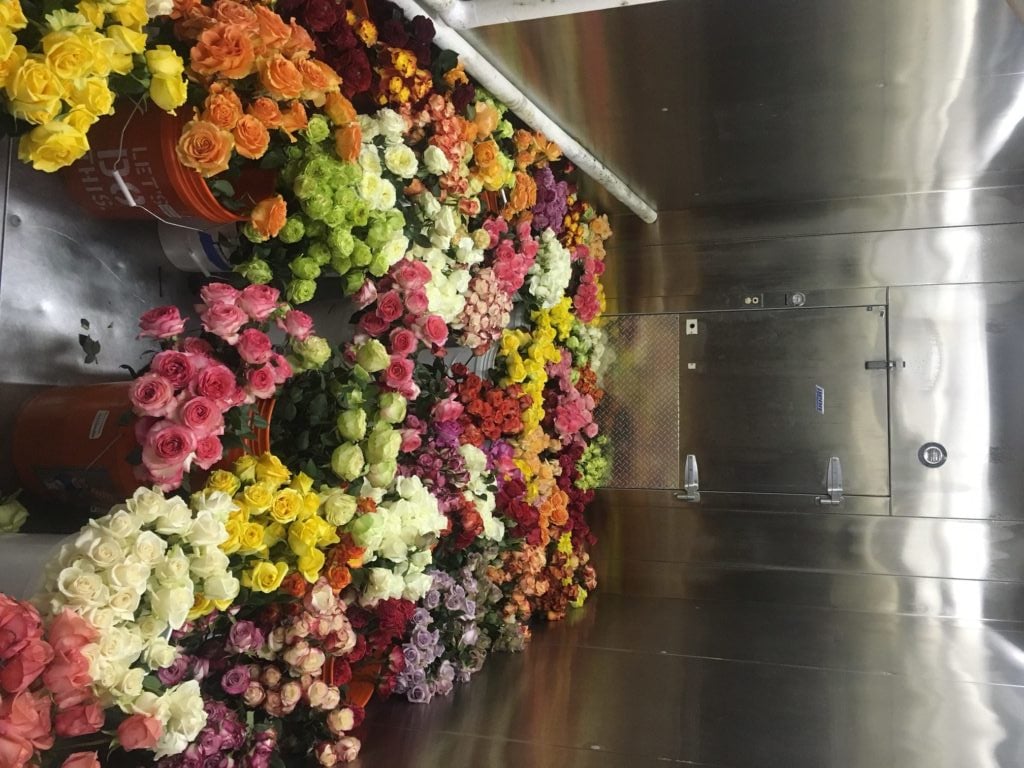Art & Exhibitions
On Site With Sarah Meyohas at Bell Labs’ Temporary Flower Factory
It was a hands-on day at her pop-up flower processing operation.

It was a hands-on day at her pop-up flower processing operation.

Kat Herriman

Last Wednesday, temporary workers arrived at Union Square for a 7:30 a.m. departure. The bus they boarded was bound for Bell Labs’ Holmdel Complex in New Jersey. Some snoozed on the hour-ish journey, which traversed the Garden State Park and its dully commercial sites. The path they followed was well-tread by the city-dwelling engineers that once commuted to the Eero Saarinen-designed campus, the site where at least one of Bell Labs’ eight Nobel Prize-winning inventions was developed.
Enumerated in Jon Gertner’s The Idea Factory: Bell Labs and the Great Age of American Innovation, the groundbreaking technologies produced by AT&T’s research and development team fundamentally changed the way we live and work. In fact, upon arrival at the now defunct facility, a water-tower shaped like one of Bell Labs’ most influential accomplishments—the transistor—greeted us.
The men on the bus arrived at 9 a.m. dressed in white shirts and black pants. Artist Sarah Meyohas had found them through a mix of personal recommendations, ManPower, and an extras agency.

Courtesy of Kat Herriman.
Saarinen’s enormous mirrored facade showcases the lab’s unusually pastoral setting. The two million square foot modernist building was once approached by a large, uninterrupted field, now there is maze of parking lots that break up the green. The local deer haven’t seemed to notice, however, they were still grazing in between the pavement. Somerset Development, a real estate conglomerate, bought the property in 2013 and is slowly converting it into a residential-meets-commercial enterprise. There are already new tenants in the behemoth, including a virtual reality firm, but the renovation process is far from complete. Many hallways are still dark, with corridors that lead to endless labs, conference rooms and cubicles.
The building serves as an intriguing impetus for Meyohas’ ambitious new project, a first for the artist on this scale.

Courtesy of Kat Herriman.
The workers had a massive task ahead: the dissection and documentation of 10,000 roses. They sat at 12 individual stations, each equipped with one chair, one light box, and one camera. These standardized desks would serve as their cubicles for the week.
Their instructions were simple: photograph every petal and set aside the best one from each. The petals will ultimately become a pixelated data set for an undetermined project.
The artist might interpolate her findings to generate new digital petals or determine the common traits of the most desirable petals. Her ends are willfully ambiguous. Unlike Bitchcoin, a invented cryptocurrency backed by her photography, Roses at Bell Labs sets no concrete agenda or value.

Courtesy of Kat Herriman.
Meyohas’ dysfunctional assembly line brought to mind Hans Ulrich Obrist’s discussion of Alighiero Boetti’s The Thousand Longest Rivers of the World in his book, Ways of Curating. “This project involved immense geographic and scientific research, but with a preordained ambiguity in the results,” he writes. “The order that has been created is, at the same time, disorder.” I imagine Boetti in the same state I found Meyohas, a couple of weeks ago: Swimming in notes and an incomprehensibly large list of references.
When I arrived on Thursday, Meyohas still faced a mountain of work. She was orchestrating her living machine as well as a video shoot. The film was taking up a majority of her attention. Snakes had been brought in and were slithering along the wires for the camera. Like the roses, they introduced another unknowable variable. Both snakes and flowers have been repeated subjects for Meyohas—appearing in her earliest photographs. “Snakes represent both good and evil. Sometimes they represent health, other times they are construed as devils,” she says. “I always like to find balance and paradox in my work.”
The film is one of the few constants. Meyohas not only documented her flower factory, but the boardrooms and boiler rooms she discovered over multiple site visits.
No help to the film crew, I sat down to press the petals that had been set aside by the workers. I placed each petal between two cardboard index cards—labeled with the appropriate number. The task was at once satisfying and monotonous. Each worker had their own qualifications for beauty. Some looked for symmetry, others for difference or vibrancy. Not all of them were elated by their work, no matter how sweet-smelling. Some quit. The workers that stayed developed systems for optimum efficiency. They listened to music, they spoke with one another over lunch. “I don’t understand what we are doing here,” one of them grumbled. “It’s art, it doesn’t need a point,” answered another.

Courtesy of Kat Herriman.
Observing the shift change, Meyohas noted: “Beauty calls copies of itself into existence. If there is a beautiful landscape you want to draw it. If there is a beautiful person, you want to have child with them. Beauty incites reproduction.” One can only assume Meyohas considers herself an integral part of this creation process. She is the conductor of this conceptual symphony.
During one break, I spoke to one satisfied worker, whose belief in the ephemeral project verged on devotion. “What we are doing here is so important,” he said. “It’s creating beauty.” His labor was being applied to a task with no immediate reward except a basket of discarded roses. What was his function in the production of beauty? He didn’t have an answer.
This faith in uncertainty is perhaps the most poignant part of Roses at Bell Labs. Like the engineers at Bell Labs, who strived for breakthroughs in the theoretical fog that is quantum mechanics, Meyohas didn’t set out with an end in mind, but rather an interest in what a process, without a specified purpose, could reveal about us. Leaving the facility, the last sentence of Seven Brief Lessons on Physics by Italian theoretical physicist Carlo Rovelli came to mind: “Here, on the edge of what we know, in contact with the ocean of the unknown, shines the mystery and the beauty of the world. And it’s breathtaking.”